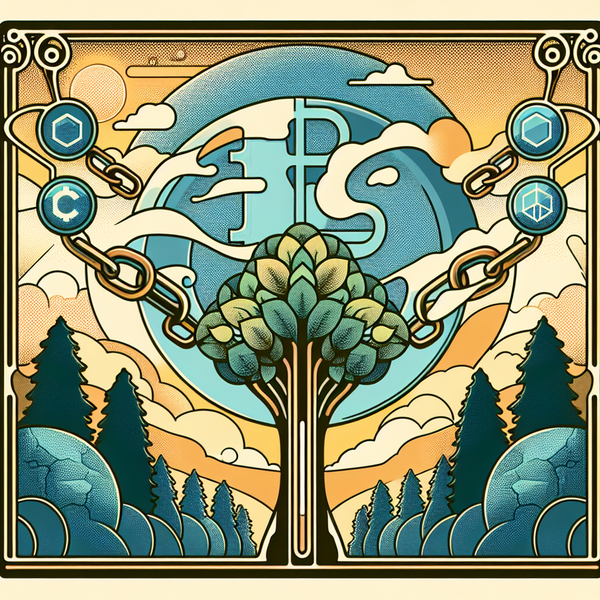Beyond Staking: How RWAs Generate Sustainable Yield from Real-World Cash Flows

In the rapidly evolving landscape of decentralized finance, investors are increasingly looking beyond traditional cryptocurrency yield mechanisms toward more sustainable and predictable revenue streams. Real-World Assets (RWAs) have emerged as a compelling alternative, offering yield backed by tangible cash flows rather than speculative token emissions or complex algorithmic strategies. This paradigm shift represents not just a new investment avenue, but potentially a more sustainable foundation for the future of DeFi.
The RWA Revolution: Yield Backed by Tangible Value
While much of DeFi's early yield generation relied on token incentives and complex yield farming strategies, RWA protocols take a fundamentally different approach. By tokenizing real-world assets and their associated cash flows, these protocols create on-chain yield that's backed by actual economic activity occurring in traditional markets.
But how exactly do these protocols transform real-world cash flows into on-chain yield? Let's examine three leading platforms that exemplify different approaches to RWA yield generation.
How Leading RWA Protocols Generate Real Yield
Goldfinch: Institutional-Grade Private Credit
Goldfinch has pioneered bringing institutional private credit on-chain through its Goldfinch Prime offering. This platform provides non-U.S. investors with exposure to a diversified pool of thousands of loans from leading private credit firms like Apollo Global Management, Ares Management, and Golub Capital—institutions that collectively manage over $1 trillion in assets under management.
The yield mechanism works through:
- Loan Selection: Goldfinch partners with established private credit firms that originate and manage senior secured loans to businesses.
- Tokenization: These loan portfolios are tokenized, allowing DeFi users to gain exposure through stablecoins.
- Yield Distribution: Interest payments from borrowers flow through to token holders, generating yields targeting 9% to 12% net of fees.
What makes Goldfinch's approach sustainable is that yields are derived from real businesses making interest payments on their loans—a cash flow that exists independently of crypto market conditions or token incentives.
Centrifuge: The On-Chain Credit Marketplace
Centrifuge takes a different approach by creating a credit marketplace that allows borrowers to finance real-world assets directly on-chain. Through Centrifuge Prime, DeFi-native organizations can tap into yields generated from real economic activity.
The protocol's yield mechanics involve:
- Asset Origination: Real-world asset originators (like those managing trade finance, invoice factoring, or real estate) tokenize their assets.
- Pool Creation: These assets are placed in pools where investors can provide liquidity.
- Cash Flow Tokenization: As borrowers make payments, these cash flows are distributed to liquidity providers.
A recent testament to Centrifuge's growing importance in the RWA ecosystem was their inclusion, alongside Anemoy and Janus Henderson, in a $200 million allocation from the $1 billion Spark Tokenization Grand Prix—one of the most competitive tokenization RFPs to date.
RedBelly Network: Infrastructure for Compliant RWA Tokenization
RedBelly Network takes yet another approach, focusing on building the foundational infrastructure for compliant tokenization of real-world assets. Their platform enables the creation of digital registries for assets and supports composable tokenized assets in structured products.
RedBelly's yield generation capability comes through:
- Tokenization Platform: Creating the infrastructure for tokenizing assets like rent rolls, private equity, and carbon credits.
- Partnership Ecosystem: Collaborating with TProtocol, a decentralized RWA lending protocol that facilitates liquidity for RWA tokens.
- Lending Markets: Enabling RWA institutions to borrow USDC against their tokens in separated pools with tailored risk parameters.
Through TProtocol's V2 lending mechanism, users can lend their USDC in an over-collateralized manner to access safe real yield backed by RWA tokens. Currently trading at around $0.0239, RedBelly Network's RBNT token has gained traction as the protocol continues to expand its RWA ecosystem.
RWA Yields vs. Traditional DeFi: A Risk-Adjusted Comparison
How do RWA yields stack up against traditional DeFi yield farming strategies when considering risk-adjusted returns? The comparison reveals several key differentiators:
| Aspect | RWA Yields | Traditional DeFi Yields |
|---|---|---|
| Typical APY Range | 6-13% | 7-15% (potentially higher with leverage) |
| Yield Source | Real economic activity (loan payments, asset cash flows) | Token emissions, trading fees, leverage |
| Risk Profile | Low to moderate risk | Moderate to high risk |
| Market Correlation | Lower correlation to crypto market cycles | Highly correlated to market conditions |
| Sustainability | Based on ongoing real-world cash flows | Often dependent on token emissions or arbitrage |
While traditional DeFi yield strategies may offer temporarily higher returns, they come with significant drawbacks that impact their long-term sustainability:
Limitations of Traditional DeFi Yield Strategies
- Impermanent Loss: Liquidity providers face potential losses from price volatility between paired assets.
- Emission-Dependent Yields: Many protocols rely on token emissions that diminish over time, leading to yield decay.
- Market Volatility Exposure: Returns are heavily influenced by general crypto market conditions.
- Smart Contract Vulnerabilities: Complex yield optimization strategies increase security risks.
- High Gas Fees: Transaction costs can significantly impact net returns, especially during network congestion.
The Sustainability Advantage of RWA Yields
What makes RWA yields more sustainable in the long run? Several factors contribute to their durability:
1. Connection to Real Economic Value
Unlike speculative DeFi mechanisms, RWA yields are tied to tangible economic activities. When a business repays a loan facilitated through Goldfinch, that payment represents real value creation in the economy. This fundamental connection to productivity creates a sustainable foundation for yield generation.
2. Diversification Across Economic Sectors
RWA protocols tap into diverse economic sectors—from real estate and private credit to carbon credits and trade finance. This diversification provides resilience against crypto-specific market downturns and creates more stable yield opportunities across market cycles.
3. Regulatory Alignment
Many RWA protocols, like RedBelly Network, prioritize regulatory compliance from the ground up. This approach reduces regulatory risks and positions these protocols for institutional adoption, bringing more capital and stability to the ecosystem.
As RedBelly's Chairman @AlanGBurt noted at the RWA Summit in Singapore: there's a "growing focus on compliance and regulation" and "development of licensed infrastructure for digital asset distribution"—trends that favor compliant RWA platforms.
4. Counter-Cyclical Opportunities
Traditional financial markets often move in different cycles than cryptocurrency markets. By bridging these worlds, RWA protocols can offer yield opportunities that perform even when crypto markets are down, providing valuable diversification for DeFi users.
The Future of Sustainable Yield in DeFi
As the RWA sector continues to mature, several trends are emerging that will shape the future of sustainable yield generation:
Institutional Adoption Accelerating
Major financial institutions are increasingly exploring tokenized RWAs. Goldfinch's partnerships with trillion-dollar asset managers like Apollo and Ares signal growing institutional confidence in on-chain RWAs. This trend brings legitimacy, liquidity, and potentially more stable yields to the space.
Expanding Asset Classes
While early RWA protocols focused primarily on credit and fixed-income products, the universe of tokenized assets is rapidly expanding. Platforms are now exploring tokenization of diverse assets including:
- Real estate (both residential and commercial)
- Carbon credits (with CarbonHood and RedBelly tokenizing $70B in carbon credits)
- Private equity (Liquidise and RedBelly tokenizing $800M in unlisted private equity)
- Government treasuries (Ondo Finance's OUSG)
- Commodities (Swarm Markets' tokenized gold)
This expansion creates more opportunities for yield diversification and tailored risk profiles.
Cross-Chain Integration
As RWA protocols develop cross-chain capabilities, users will gain access to real-world yields across multiple blockchain ecosystems. This interoperability will further enhance liquidity and accessibility for RWA-backed yields.
Conclusion: The Path Forward
The shift toward RWA-generated yields represents a crucial evolution for DeFi—one that moves beyond speculative mechanisms toward sustainable, real-world value creation. By tapping into tangible cash flows from diverse economic activities, RWA protocols offer a more durable foundation for yield generation that can weather market volatility and regulatory scrutiny.
For investors seeking to diversify beyond traditional staking and yield farming, protocols like Goldfinch, Centrifuge, and RedBelly Network provide access to yields backed by real economic activity rather than speculative token emissions or temporary arbitrage opportunities.
As the line between traditional finance and DeFi continues to blur, RWA protocols stand at the forefront of creating a more sustainable, accessible, and resilient financial system—one where yield represents genuine economic productivity rather than financial engineering.
The next phase of DeFi's evolution isn't just about higher APYs—it's about building yield mechanisms that can endure for decades rather than cycles. RWAs may well be the foundation upon which that lasting financial infrastructure is built.




